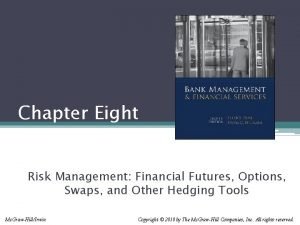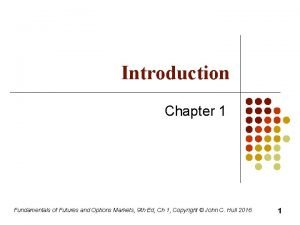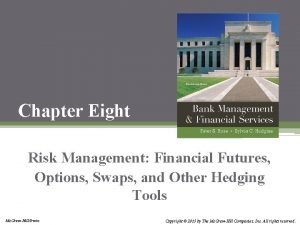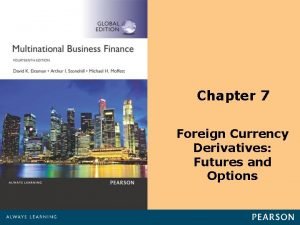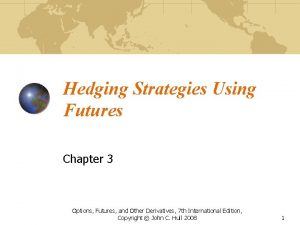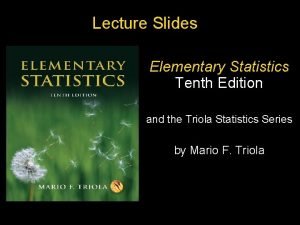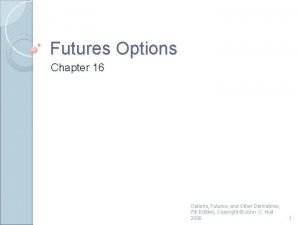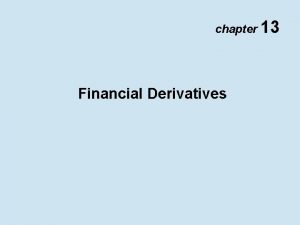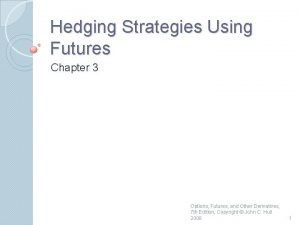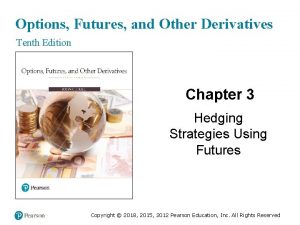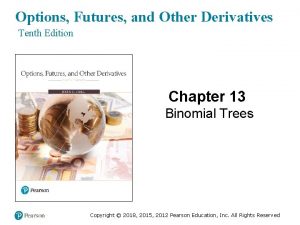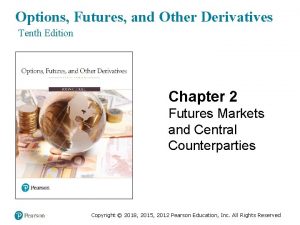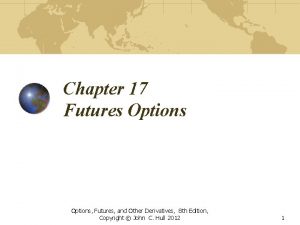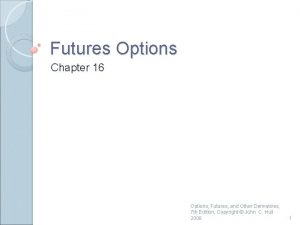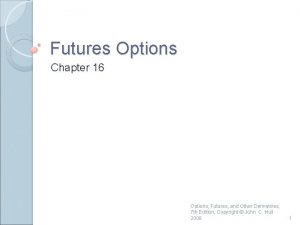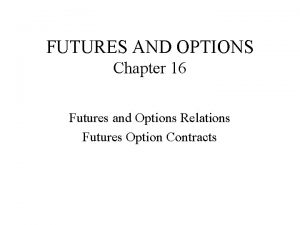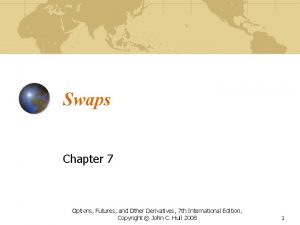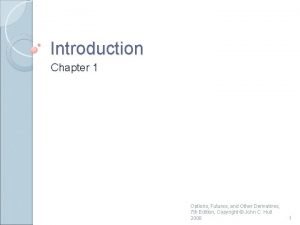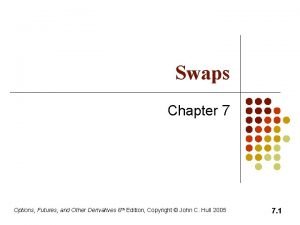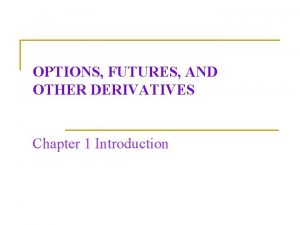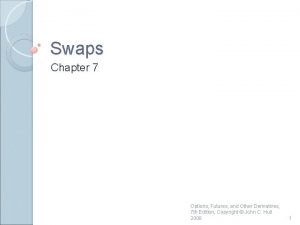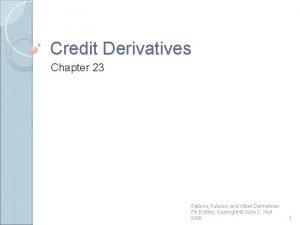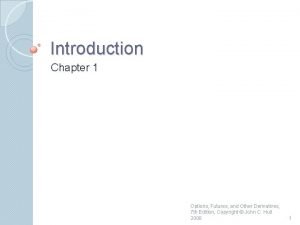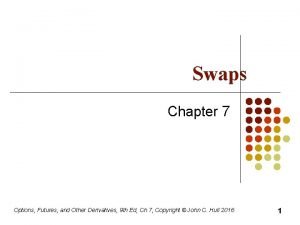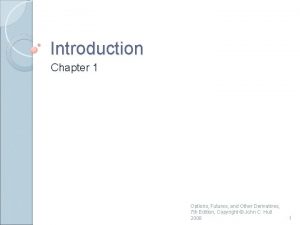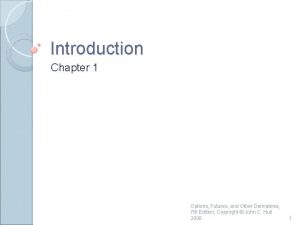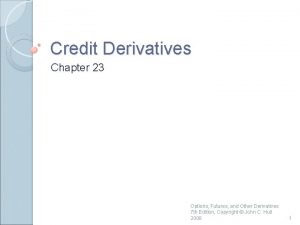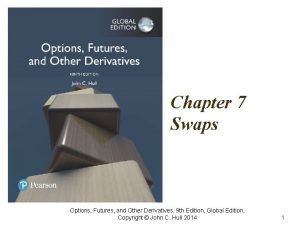Options Futures and Other Derivatives Tenth Edition Chapter




























- Slides: 28

Options, Futures, and Other Derivatives Tenth Edition Chapter 10 Mechanics of Options Markets Copyright © 2018, 2015, 2012 Pearson Education, Inc. All Rights Reserved

Review of Option Types • A call is an option to buy • A put is an option to sell • A European option can be exercised only at the end of its life • An American option can be exercised at any time • Expiration Date or Maturity Date • Exercise Price or Strike Price • Option Price or Option Premium Copyright © 2018, 2015, 2012 Pearson Education, Inc. All Rights Reserved

Profit/Loss on Call Options Copyright © 2018, 2015, 2012 Pearson Education, Inc. All Rights Reserved

Profit/Loss on Call/Put Options Copyright © 2018, 2015, 2012 Pearson Education, Inc. All Rights Reserved

Option Positions • Long call • Long put • Short call / Writer of Call Option • Short put / Writer of Put Option Copyright © 2018, 2015, 2012 Pearson Education, Inc. All Rights Reserved

Long Call (Figure 10. 1, Page 210) Profit from buying one European call option: option price = $5, strike price = $100, option life = 2 months 30 Profit ($) 20 10 0 -5 Terminal 70 80 90 100 stock price ($) 110 120 130 The payoff : Max(ST – K, 0) Copyright © 2018, 2015, 2012 Pearson Education, Inc. All Rights Reserved

Short Call (Figure 10. 3, page 212) Profit from writing one European call option: option price = $5, strike price = $100 Profit ($) 5 0 110 120 130 70 80 90 100 -10 Terminal stock price ($) -20 -30 The payoff : - Max(ST – K, 0) Copyright © 2018, 2015, 2012 Pearson Education, Inc. All Rights Reserved

Long Put (Figure 10. 2, page 211) Profit from buying a European put option: option price = $7, strike price = $70 30 Profit ($) 20 10 0 -7 Terminal stock price ($) 40 50 60 70 80 90 100 The payoff : Max(K - ST, 0) Copyright © 2018, 2015, 2012 Pearson Education, Inc. All Rights Reserved

Short Put (Figure 10. 4, page 212) Profit from writing a European put option: option price = $7, strike price = $70 Profit ($) 7 0 Terminal 40 50 60 stock price ($) 70 80 90 100 -10 -20 -30 The payoff : - Max(K - ST, 0) Copyright © 2018, 2015, 2012 Pearson Education, Inc. All Rights Reserved

Payoffs from Options What is the Option Position in Each Case? K = Strike price, ST = Price of asset at maturity Payoff K K ST ST Copyright © 2018, 2015, 2012 Pearson Education, Inc. All Rights Reserved

Assets Underlying Exchange-Traded Options (Page 214 -215) • Stocks • ETFs (and other ETPs) • Foreign Currency • Stock Indices Copyright © 2018, 2015, 2012 Pearson Education, Inc. All Rights Reserved

Specification of Exchange-Traded Options • Expiration date • Strike price • European or American • Call or Put (option class) Copyright © 2018, 2015, 2012 Pearson Education, Inc. All Rights Reserved

Terminology (1 of 2) Moneyness: – At-the-money option – In-the-money option – Out-of-the-money option Copyright © 2018, 2015, 2012 Pearson Education, Inc. All Rights Reserved

Terminology (2 of 2) • Option class • Option series • Intrinsic value • Time value Copyright © 2018, 2015, 2012 Pearson Education, Inc. All Rights Reserved

Other CBOE Products • Flex options • Weeklys • Binary options Copyright © 2018, 2015, 2012 Pearson Education, Inc. All Rights Reserved

Cash / Stock Dividends and Stock Splits (Page 217 -218) (1 of 2) • Suppose you own N options with a strike price of K: – No adjustments are made to the option terms for cash dividends – When there is an n-for-m stock split, ▪ the strike price is reduced to m. K/n ▪ the no. of options is increased to n. N/m – Stock dividends are handled similarly to stock splits Copyright © 2018, 2015, 2012 Pearson Education, Inc. All Rights Reserved

Dividends and Stock Splits (2 of 2) • Consider a call option to buy 100 shares for $20/share • How should terms be adjusted: – for a 2 -for-1 stock split? – for a 5% stock dividend? Copyright © 2018, 2015, 2012 Pearson Education, Inc. All Rights Reserved

Position Limits and Exercise Limits • Position limits defines the maximum number of option contracts that an investor can hold on one side of the market. For this purpose, long calls and short puts are considered to be on the same side of the market • Exercise Limits usually equals the position limit and defines the maximum number of contracts that can be exercised by any individual in any period of five consecutive business days. • For the largest and most frequently traded stocks: 250, 000 contracts • For smaller capitalization stocks: 25, 000 – 200, 0000 contracts

Market Makers • Most exchanges use market makers to facilitate options trading • A market maker quotes both bid and ask prices when requested • The market maker does not know whether the individual requesting the quotes wants to buy or sell Copyright © 2018, 2015, 2012 Pearson Education, Inc. All Rights Reserved

Margin (Pages 221 -222) • Margin is required when options are sold • When a naked option is written the margin is the greater of: – A total of 100% of the proceeds of the sale plus 20% of the underlying share price less the amount (if any) by which the option is out of the money – A total of 100% of the proceeds of the sale plus 10% of the underlying share price (call) or exercise price (put) • For other trading strategies there are special rules Copyright © 2018, 2015, 2012 Pearson Education, Inc. All Rights Reserved

Margin (Pages 221 -222)

Warrants (1 of 2) • Warrants are options that are issued by a corporation or a financial institution • The number of warrants outstanding is determined by the size of the original issue and changes only when they are exercised or when they expire • The issuer settles up with the holder when a warrant is exercised • When call warrants are issued by a corporation on its own stock, exercise will usually lead to new treasury stock being issued Copyright © 2018, 2015, 2012 Pearson Education, Inc. All Rights Reserved

Employee Stock Options (see also, Chapter 16) • Employee stock options are a form of remuneration issued by a company to its executives • They are usually at the money when issued • When options are exercised the company issues more stock and sells it to the option holder for the strike price • Expensed on the income statement Copyright © 2018, 2015, 2012 Pearson Education, Inc. All Rights Reserved

Convertible Bonds • Convertible bonds are regular bonds that can be exchanged for equity at certain times in the future according to a predetermined exchange ratio • Usually a convertible is callable • The call provision is a way in which the issuer can force conversion at a time earlier than the holder might otherwise choose Copyright © 2018, 2015, 2012 Pearson Education, Inc. All Rights Reserved

Practice Questions Problem 10. 1. An investor buys a European put on a share for $3. The stock price is $42 and the strike price is $40. Under what circumstances does the investor make a profit? Under what circumstances will the option be exercised? Draw a diagram showing the variation of the investor’s profit with the stock price at the maturity of the option. Problem 10. 2. An investor sells a European call on a share for $4. The stock price is $47 and the strike price is $50. Under what circumstances does the investor make a profit? Under what circumstances will the option be exercised? Draw a diagram showing the variation of the investor’s profit with the stock price at the maturity of the option.

Practice Questions Problem 10. 4. Explain why margin accounts are required when clients write options but not when they buy options. Problem 10. 6. A company declares a 2 -for-1 stock split. Explain how the terms change for a call option with a strike price of $60. Problem 10. 17. Consider an exchange-traded call option contract to buy 500 shares with a strike price of $40 and maturity in four months. Explain how the terms of the option contract change when there is A 10% stock dividend A 10% cash dividend A 4 -for-1 stock split

Practice Questions Problem 10. 22. A U. S. investor writes five naked call option contracts. The option price is $3. 50, the strike price is $60. 00, and the stock price is $57. 00. What is the initial margin requirement?

Copyright © 2018, 2015, 2012 Pearson Education, Inc. All Rights Reserved
 Options, futures, and other derivatives
Options, futures, and other derivatives Options futures and risk management
Options futures and risk management Forward vs option
Forward vs option Options futures and risk management
Options futures and risk management Currency futures
Currency futures Hedging strategies using futures and options
Hedging strategies using futures and options Campbell biology tenth edition
Campbell biology tenth edition Campbell biology tenth edition
Campbell biology tenth edition Campbell biology tenth edition
Campbell biology tenth edition Elementary statistics tenth edition
Elementary statistics tenth edition Digital fundamentals tenth edition floyd
Digital fundamentals tenth edition floyd Corporate finance tenth edition
Corporate finance tenth edition Psychology tenth edition in modules
Psychology tenth edition in modules Introduction to genetic analysis tenth edition
Introduction to genetic analysis tenth edition Corporate finance tenth edition
Corporate finance tenth edition Corporate finance tenth edition
Corporate finance tenth edition Corporate finance tenth edition
Corporate finance tenth edition Corporate finance tenth edition
Corporate finance tenth edition Campbell biology tenth edition
Campbell biology tenth edition Biology tenth edition
Biology tenth edition Biology tenth edition
Biology tenth edition Biology tenth edition
Biology tenth edition Futures style options
Futures style options Advantages and disadvantages of derivatives
Advantages and disadvantages of derivatives Tenth chapter wired
Tenth chapter wired Tenth may dawned bright and clear
Tenth may dawned bright and clear Mis chapter 6
Mis chapter 6 Using mis 10th edition
Using mis 10th edition Derivatives hedging strategies
Derivatives hedging strategies

